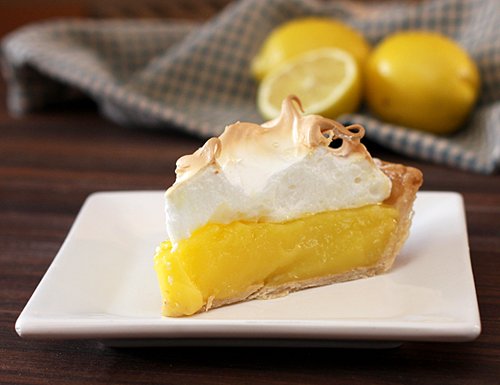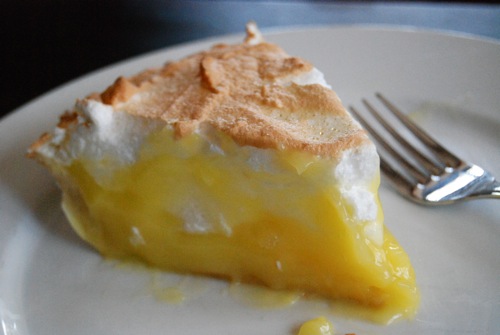Okay, I used the old journalism trick of hijacking you with the headline. I confess that it was a bit misleading. The contest wasn’t really about the lemon pie filling; It was about the crust. And I wasn’t sure you would click on a post about a pie crust smackdown. But hey, before you abandon me in annoyance, let me tell you that the filling was also really great. And I’m going to give you the recipe, too. So there.
Before I dive into the lemon pie smackdown, though, a quick bit of CurvyMama history: Remember the apple pie smackdown that I conducted at work a while back? I made two pies from the same recipe, but baked one the traditional way and one in a paper bag. Then I took them to work and let the ravenous but very observant and articulate journalists I work with tell me which they preferred, and why. Their feedback was really interesting. (See my posts about the making of the pies, and the tasting, for a refresher.)
Since I’ve been so immersed in things like creme brulee and Danish pastry for weeks now in class at L’Academie de Cuisine, I’ve built up quite a powerful longing to return to piemaking. A crazy work travel schedule delayed and intensified the longing. Last night I gave it full rein; I spent the evening making two lemon pies.
Why lemon? Because lemons sing to me of spring and brightly colored things. Because I love the puckery tartness combined with the silky texture and nice marshmallowy meringue (okay, sometimes the meringue comes out nicely. Sometimes it, um, doesn’t. More on that shortly.) But mostly, last night, I made lemon pies because I had a bunch of lemons in the house, and because I just had to get my hands back in dough. And I’ve been wanting to try crusts made from a combination of shortening and butter instead of my old standby all-butter pastry. And I wanted to compare the two kinds of crusts. Who better to ask than my eager colleagues?
So I made one batch of sour cream pastry crust with all butter, and one batch with half butter and half shortening. I used Spectrum brand organic vegetable shortening and Land O’ Lakes unsalted butter. I blind baked them, cooled them slightly, and poured in the double batch of lemon filling I had made. I used the egg whites from the lemon filling to whip up a meringue base, and I poured hot sugar syrup into the beaten whites to make an Italian meringue. That’s where things went wrong.
Trusting my candy thermometer, I pulled the syrup off the heat when it registered 236 degrees, and poured it right into the meringue as the whip attachment of my mixer was still going, the way we had done in pastry class (and I have done on my own at home). Perhaps my thermometer was wrong, and the syrup had already reached “hard ball” stage, though, because when it hit the meringue, it hardened and made frightful little thwacking noises against the metal mixing bowl. This problem, which caused me palpitations at 10 p.m., seemed to ease as I kept whipping the meringue. But the meringue just never took on that lovely sheen and smooth texture it was supposed to.
So I wish I could tell you that the pie photo at the top of this post is a picture of my pie (it isn’t) or, at the very least, that this photo looks like my pie (it damn well doesn’t). In the spirit of full disclosure that CurvyMama abides by, I will tell you that the meringue on my pie looked more like this:
Quite a disappointment, to say the least. But because my dear colleagues have such low standards open minds, I knew I could bring even the ugliest pies in for a warm reception. And I knew they would be intrigued and engaged by the idea of a comparison, since our quest focused not on the failed meringue, but on another element of the pie (I didn’t tell them exactly what).
So there they were, lined up sweetly with their little forks and plates, waiting for their chance to tell me whether they detected a difference between the two pies.
They focused on the filling at first, since that is by far the flashiest element of the pie. One particularly foodie colleague, Matthew, about his very-elegant workplace meals, picked up on the difference: Pie #1, he noticed, (the one made with butter and shortening) had a more tender crust; Pie #2 (all-butter) had a firmer crust. A-ha, I told him; you’re onto something!
Since Matthew had scurried off to the conference room to eat his pie, our coworkers didn’t hear him; they were still in the kitchen, slicing and munching. They didn’t pick up on the crust issue right away, so I took mercy on them and tipped them off that the crust was the mystery difference.
Okay, they said, with renewed determination to solve the mystery. One by one, they started noticing the difference in flavor. Pie #2 had a nicer, stronger flavor; They loved it. But Pie #1 did have that tender, flakier crust, they noted. So the difference in texture was clear to everyone. Then it just came down to preference; those who liked a crust that resisted their teeth a bit more–or those for whom flavor trumped everything–voted for the butter crust. The tender folks voted for butter-shortening.
Here are the recipes, so you can try them and see what you think. I will tell you that the lemon filling didn’t set up as firmly as I would have liked. But since this is a full-disclosure blog, I share it with you anyway. I am still questing for a filling that holds its shape like the one in the photo at the top of this post.
Lemon Pie Filling
1 1/2 c. sugar
3 Tbsp. cornstarch
1/4 tsp. salt
1 1/2 c. water
1/2 c. lemon juice (about 2 lemons)
4 eggs, separated, with the whites reserved for the meringue
2 Tbsp. butter, chopped into small pieces
Combine the sugar, cornstarch and salt in a saucepan. Add the water and lemon juice and combine. Put the pan over medium-high heat, stirring occasionally.
In a bowl, whisk together the egg yolks until lightened.
When the sugar-water mixture gets hot enough to emit steam, drizzle about one-third of it into the egg yolks, whisking constantly. Pour the tempered eggs back into the saucepan and cook over medium-high heat, whisking constantly.
Cook and whisk until the filling is thick, easily coating the back of a spoon. Stir in the chopped butter until it is fully incorporated. Place a sheet of plastic wrap over the filling to keep it hot and keep a film from forming. You will want to assemble your pie when the filling is still pretty hot, so time the crust, meringue and filling accordingly.
Sour Cream Pie Crust (adapted from Rose Levy Beranbaum)
1 1/3 c. plus 4 teaspoons pastry flour or 1 1/3 c. bleached all-purpose flour
a pinch or two of salt
4 oz. (8 Tbsp.) unsalted butter (or 2 oz./4 Tbsp. butter and 2 oz./4 Tbsp. shortening)
4 Tbsp. sour cream
2-4 Tbsp. icewater
In a mixing bowl, combine the flour and salt.
Cut your butter (or butter and shortening if you are doing the half-and-half recipe) into small pieces and freeze for at least 15 minutes.
When the fats have chilled, cut them into the flour with a pastry cutter in two additions. In the first addition, cut the pieces up very small, so the mixture resembles coarse meal. In the second addition, leave some bigger pieces, about the size of kidney beans.
Add the sour cream, mixing as little as possible to avoid building gluten, which will make the crust tough. I found that the crust wasn’t moist enough after adding the amount of sour cream Rose suggested, so I added a few tablespoons of icewater to get to the desired pliable texture. Add as little water as possible, but enough to enable the dough to hold together.
Shape dough into a rough disk. Wrap in plastic wrap or waxed paper. Chill for at least one hour.
Preheat oven to 425. Roll out dough, line 9-inch pie pan. Trim and crimp edges. Line dough with parchment. Fill at least half way with dried beans. Bake for about 20 minutes. Take crusts out of oven, remove beans and parchment and bake for another 5-10 minutes, until crusts are light golden brown.
Italian Meringue
4 egg whites
1/2 c. sugar
2 Tbsp. water
Put egg whites into bowl of stand mixer with whip attachment.
Combine sugar and water in a saucepan, with a candy thermometer nearby. Dip your fingers in water and “wash” the insides of the pan to ensure nothing is sticking to it that might cause crystallization.
Put a medium-high flame under the pan and cover it, watching carefully for the first bit of steam that escapes and shows the mixture is boiling.
Start beating the egg whites, on medium speed. Turn the speed up to high after a few minutes.
Remove the cover from the syrup pan and watch the mixture as it boils. Attach the candy thermometer. When it reaches 236 degrees, immediately remove it from the heat and begin pouring it, in a slow drizzle, into the egg whites, close to the edge of the mixing bowl. Take care to avoid pouring the hot syrup onto the whip attachment as it moves. Continue whipping the meringue it looks glossy and the mixing bowl is lukewarm to the touch.
Pie Assembly:
Have the oven preheated to 350.
Pour the hot lemon filling into the baked pie crust. Immediately top with meringue, using an offset spatula to make sure that the meringue reaches the crust and makes a seal. Make decorative swirls in the meringue.
Bake the pie for 5-10 minutes. Remove from oven.
Brown the meringue in one of two ways: Re-set the oven to broil, put the pie in, and watch it closely, or use a kitchen butane torch.
Cool the pie at room temperature for several hours.






